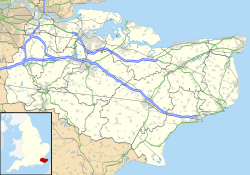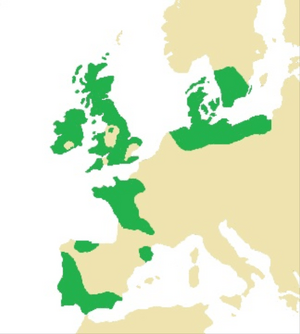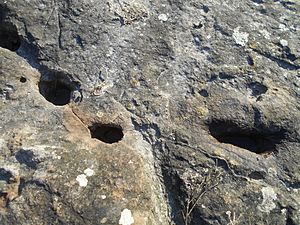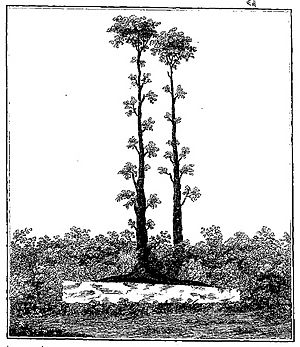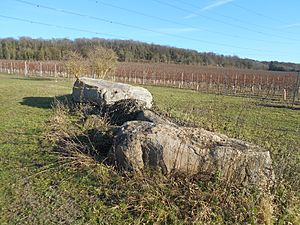Coffin Stone facts for kids
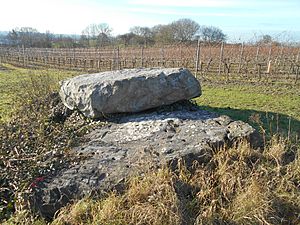
The site in 2017. The topmost stone was placed there by a farmer, and the Coffin Stone is beneath
|
|
| Coordinates | 51°19′04″N 0°29′44″E / 51.317806°N 0.495659°E |
|---|---|
| Type | Monolith; putative long barrow |
The Coffin Stone is a very large stone found near Aylesford in Kent, England. It's also known as the Coffin or the Table Stone. This huge stone, called a sarsen, now lies flat on the ground. It was probably once standing upright nearby.
Experts called archaeologists think the Coffin Stone might have been part of an ancient burial mound. This type of mound is called a chambered long barrow. It would have been built around 4,000 to 2,500 BCE, during a time called the Early Neolithic period in Britain. This was when people first started farming.
If it was a long barrow, it would have been built by early farming communities. These communities had just learned about farming from other parts of Europe. Building long barrows was a common practice across Europe during this time. In the area around the River Medway in Kent, there are several similar ancient sites. They are known as the Medway Megaliths.
The Coffin Stone is a rectangular slab. It is about 4.4 meters (14 feet 6 inches) long, 2.6 meters (8 feet 6 inches) wide, and 0.6 meters (2 feet) thick. Two smaller stones are nearby, and another large stone rests on top of it. In the 1830s, farmers reported finding human bones near the stone.
Archaeologists dug up the site in 2008 and 2009. They found that the Coffin Stone was placed in its current spot much later, between the 1400s and 1600s. They did not find any clear proof that a chambered long barrow was ever built there. However, they think the Coffin Stone might have stood upright somewhere close by.
Contents
Where is the Coffin Stone?
The Coffin Stone is located on Great Tottington Farm. This farm is now a vineyard, which is a place where grapes are grown.
As of 2005, there were no signs pointing to the site. But you could reach it by following a path called the Pilgrims' Way. The Coffin Stone is about 400 meters (1,300 feet) north-west of another ancient site called Little Kit's Coty House.
What was life like back then?
The Early Neolithic period was a time of big changes in Britain. Between 4500 and 3800 BCE, people started farming instead of hunting and gathering food. This new way of life came from Europe. It's not clear if new people moved to Britain or if the people already living there learned farming from others.
The area of modern Kent was important because it was close to Europe. This made it easy for people and ideas to travel there. Most of Britain was covered in forests during this time. Large parts of the forests were not cleared until much later, around 1000 to 700 BCE.
Archaeologists believe that early farming in Britain mainly involved herding cattle. People probably moved around a lot, rather than staying in one place.
What are the Medway Megaliths?
During the Early Neolithic, people in Western Europe started building huge structures for the first time. These included chambered long barrows. These were long, rectangular mounds of earth with a chamber built inside. Some chambers were made of wood, while others used very large stones called "megaliths."
Long barrows were often used as tombs. They held the bodies of people who had died. People were usually buried together in these tombs, not alone. This way of building tombs spread across Europe and came to Britain around 4000 BCE.
The Medway Megaliths are a group of these ancient monuments in Kent. They are found along the River Medway. These sites would have been some of the biggest and most impressive ancient tombs in Britain when they were built. Experts say they are some of the most interesting archaeological sites in Kent.
The Medway Megaliths are split into two groups. One group is west of the River Medway, and the other is on Blue Bell Hill to the east. They are about 8 to 10 kilometers (5 to 6 miles) apart. The western group includes Coldrum Long Barrow, Addington Long Barrow, and the Chestnuts Long Barrow. The eastern group has Smythe's Megalith, Kit's Coty House, and Little Kit's Coty House.
All the Medway long barrows were built in a similar way. They were usually aligned from east to west. Each had a stone chamber at the eastern end of the mound. They probably also had a stone front at the entrance. The chambers could be as tall as 3 meters (10 feet). This made them taller than most other long barrows in Britain.
The chambers were built using sarsen stone. This is a very hard and strong stone found naturally in Kent. Builders would have chosen large blocks of stone from the local area. Then, they would have moved them to the building site. These shared features show that the Medway Megaliths were a unique group in Britain.
What does the Coffin Stone look like?
The Coffin Stone is a very large rectangular stone slab. In the 1870s, it was measured to be about 4.4 meters (14 feet 6 inches) long. It was also 2.6 meters (8 feet 6 inches) wide and about 0.6 meters (2 feet) thick. One archaeologist said "the Coffin Stone" was a good name for it because of its shape.
If this stone was part of an ancient chamber, that chamber would have been very large. It could have been as tall as 3.75 meters (12 feet). This would make it the biggest chamber among all the known Medway Megaliths. Another large sarsen stone was placed on top of the Coffin Stone sometime in the 1900s.
In the 1800s, human bones were found near the stone. This made some archaeologists think the Coffin Stone was what was left of a destroyed long barrow. Some thought they could still see traces of a mound around it. However, archaeological digs in the 2000s did not find clear proof of a long barrow there.
Who studied the Coffin Stone?
Early descriptions
The Coffin Stone was first written about in a book called Itinerarium Curiosum in 1776. This book also had the first drawing of the stone. Later, in 1788, another person named John Thorpe described the site. He drew two pictures of it. One showed a thin tree growing around the stone.
Around 1840, Beale Poste visited the site and drew a sketch. He wrote that in 1838 or 1839, a bag of human bones was found near the Coffin Stone. In 1871, E. H. W. Dunkin wrote about the stone. He said it was also called "The Table Stone." He thought it had once stood upright as a memorial for an ancient British leader. Dunkin also noted that Roman pottery pieces were found nearby.
In 1893, George Payne wrote about the monument. He said it was known locally as both the Coffin Stone and the General's Stone. However, another expert later thought Payne might have mixed up the Coffin Stone with a different stone. In 1924, archaeologist O. G. S. Crawford listed the Coffin Stone with the other Medway Megaliths.
In 1927, William Coles Finch published the first photograph of the Coffin Stone. His son was standing on it in the picture. Finch also noticed that the stone had been damaged by farming. In 1946, an article mentioned that the Coffin Stone, like other large stones in the area, was linked to a burial after a battle in the 400s. This idea came from old stories and local legends.
Modern archaeological studies
In 2005, an archaeologist named Paul Ashbee tried to get the Coffin Stone protected by law. But the group in charge, English Heritage, said they wouldn't protect it. They thought it was a natural rock formation, not something made by people. Ashbee disagreed, saying it was important to protect national monuments.
Ashbee suggested that digging or using special equipment could find more evidence. So, in 2008 and 2009, archaeologists led by Paul Garwood studied the site. They found signs of ancient activity nearby. But they couldn't figure out exactly when these things happened.
The archaeologists confirmed that there was no evidence of a chambered long barrow at that exact spot. They found that the stone was moved to where it is now sometime between 1450 and 1600. They also found a large hollow in the ground nearby. They think this hollow was where the Coffin Stone originally stood upright before it was moved.
See also
 In Spanish: Piedra Coffin para niños
In Spanish: Piedra Coffin para niños


